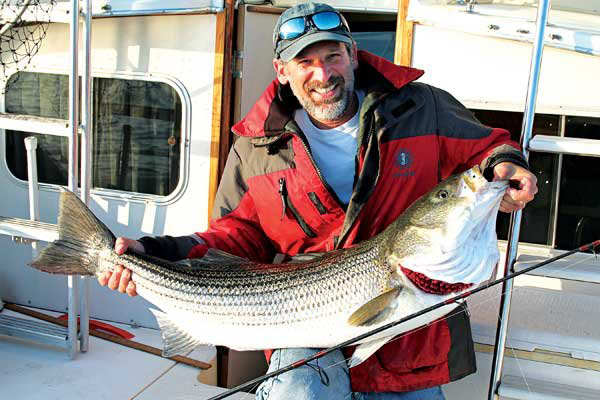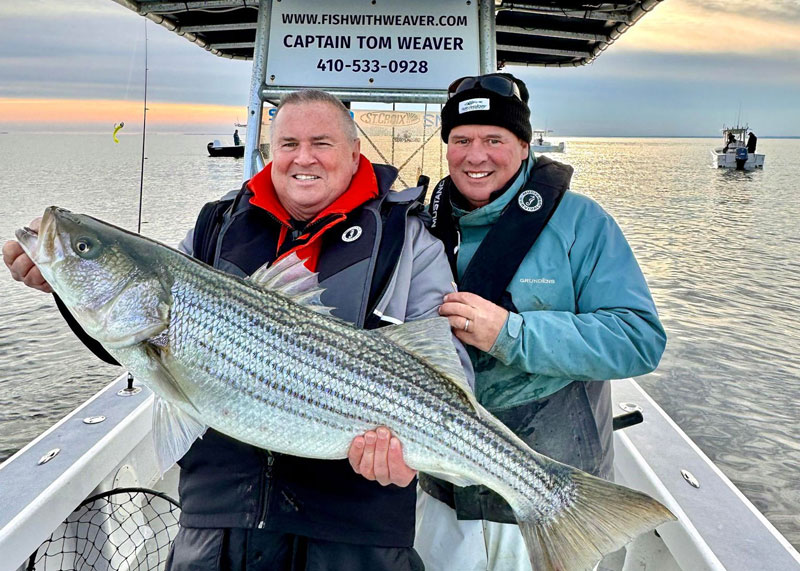As we prepare for striped bass to open in the Chesapeake Bay, we look back at our first year with no spring trophy season. Virginia shut it down several years back and Maryland eliminated it in 2024. The below editorial was written five years earlier and at that time, the decline in the fishery was already quite apparent to many of us. Let's get a remineded of the 2019 mindset, before taking a look at what might lie in store.
April 25, 2019: Can you feel it, FishTalk readers? There’s an electricity in the air, a buzz in the tackle shops and a chaotic frenzy in the boatyards – trophy striper season in coming up fast. Wherever in the region you live, whether you fish in the Chesapeake Bay or along the Atlantic coast, those big cow rockfish are about to be set squarely in the sights as tens or perhaps even hundreds of thousands of us get ready to pull the trolling trigger or charge forth with chum.

Is this a good thing?
It’s certainly a debatable point. On the one hand, the potential for catching monstrous fish does get people charged up. It’s a tackle- and boat-buying catalyst that prompts excited anglers to spend their hard-earned cash in the fishing and boating businesses that exist to help us in our angling endeavors. And it tempts newcomers into the fishing community while also supporting the charter fleet. In turn the trophy season generates much of the revenue that helps state and federal agencies manage the fishery in a (hopefully) sensible way. So our pursuit of these fish helps in the protection of these fish.
On the other hand, we are hunting the breeding stock. According to the U.S. Fish & Wildlife Service, a 15-year-old 45-inch, 35- to 40-pound fish can produce around three million eggs (six times as many as a 28-inch fish). It would be great if we could just target males, but we can’t. Years ago I was quite proud of my ability to do so and often preached spring bait fishing because over three-quarters of the fish caught with my tactics were very large males; the one pictured here, indicative of the average body shape, measured in the mid-40’s but barely weighed 30 pounds – you can see how skinny it is. For whatever reason, the fish started acting differently the last few seasons and females simply can’t be avoided (though if anyone has insight into how it might be possible, by all means, please share it with us!)
Should we be killing these big fat cows, on their way to the spawning grounds? It’s very easy to come up with a gut reaction, but very difficult to reason through an extraordinarily complex issue to come to an equitable conclusion. It’s 100-percent impossible to come to a conclusion that will satisfy everyone. I’m no scientist, nor do I depend on trophy striper season for an income. But I have been fishing the Bay for many decades and can clearly remember when catching a striped bass was an anomaly that only occurred on rare occasions. I can also remember the first few seasons after the moratorium was lifted, when it seemed like there were so many rockfish you could catch a trophy with a worm on a bent paperclip. So as we all think through what is “right,” I hope anglers will keep these additional important points in mind:
- Whatever you may feel the quality of the striper fishery is currently, the management practices which have been used since the moratorium was put in place have maintained the species’ existence thus far.
- Big cow fish are simply not as good for eating as smaller stripers are.
- Many people do depend on trophy season for a significant portion of their income.
- Taking many multiple small fish has much less of an impact on the stock than taking a single trophy does.
- You, me, and everyone else has no right to dictate what anyone else “should” do with the fish they catch. As long as all the laws are followed and a fish is legally caught, it’s up to the individual angler to decide what he or she will do with it.
- Even catch-and-release trophy fishing, preached by many with good intent and positive result, is not completely cost-free. However careful an angler may be, if you hook large numbers of fish sooner or later one will be deep-hooked, lose an eye, snag a gill, or otherwise die as a result of the encounter.
Notice a pattern? For, against. For, against. The arguments could, should, and I’m sure will, go on forever. Personally, I’d never dream of denying someone else the opportunity to take home their fish of a lifetime. Nor do I want to dream of the days when striped bass are again an anomaly. So I say enjoy the trophy season and enjoy the pre-season – but enjoy them judiciously. I’ll personally commit to killing no more than one trophy fish this season. How many you box this season is entirely your own choice, but I hope some folks will consider doing the same – without passing judgement on those who choose otherwise.

December/January, 2023/2024: Where did all these huge rockfish come from? This winter we enjoyed the best run of 40-inch-plus fish in recent memory. This was an entirely catch-and-release fishery, taking place well after the season was closed. We simply got lucky - it happened in New York earlier in 2023, too, even as nearby waters were barren. This one big body of fish tended to travel the same area at the same time, making it easy to believe the stocks are healthy even though in reality 10 miles away and beyond, rockfish were few and far between. Here in the Middle Chesapeake we simply got lucky. There was a bumper crop of bunker coming out of the creeks and rivers, and when the rockfish found 'em they stuck close. It could happen again next winter, or it might happen again... never.
What we learned, however, is that from an economic standpoint catch-and-release fishing is a hands-down winner. Guides were booked solid, tackle shops sold jigs hand over fist, recreational boaters kept their boats in the water longer than usual, and the marinas were busier than anyone could remember for that time of year. And all this was during the timeframe when studies show catch-and-release mortality is incredibly low - a mere 1.6 percent. Could fisheries managers possibly hope for a better scenario than economic boom coupled with absolutely minimal impact to the fishery?
May 10, 2024: What have we learned through our first spring in decades with no trophy season? For starters, yes it did hurt the charter fleet. Some managed to switch to targeting catfish but some had trouble filling the boat, and others opted to sit on the sidelines. It also hurt the tackle shops, and in a big way. At least two have announced they are closing their doors permanently in recent months. Marinas report less use at the dry stacks and fuel docks, and while there are many other contributing factors to new boat sales, these are down as well. So, yes - the economic pain has been very real.
Has it been worth it? We simply don't know and we won't know for years, or maybe forever. Striped bass populations are subject to far more influences than recreational angling. We do know, however, that recreational angling remains under threat from multiple directions. Commercial and (some) charter interests are pointing the finger at recreational anglers and claiming they're responsible for the stock's decline - even as many of the same people continue to insist there is actually no problem with the stock. Legislators have introduced bills (unsuccessfully thus far, thank goodness) to eliminate catch-and-release fishing for more of the season. And the 2024 regular striped bass season will be more restrictive this year than it has been since the moratorium. We'll have to wait and see what happens next...
- Lenny Rudow
Editor's Note: The bulk of this article was originally published in April of 2019. It was last updated on May 10, 2024.